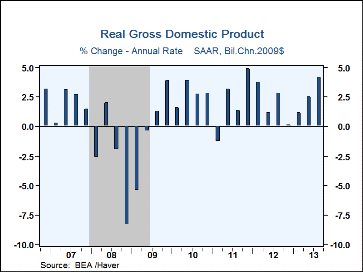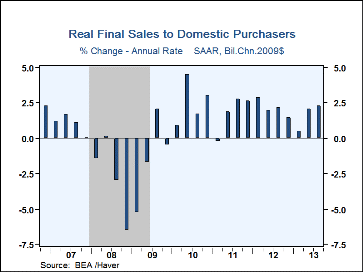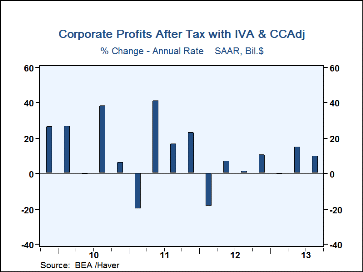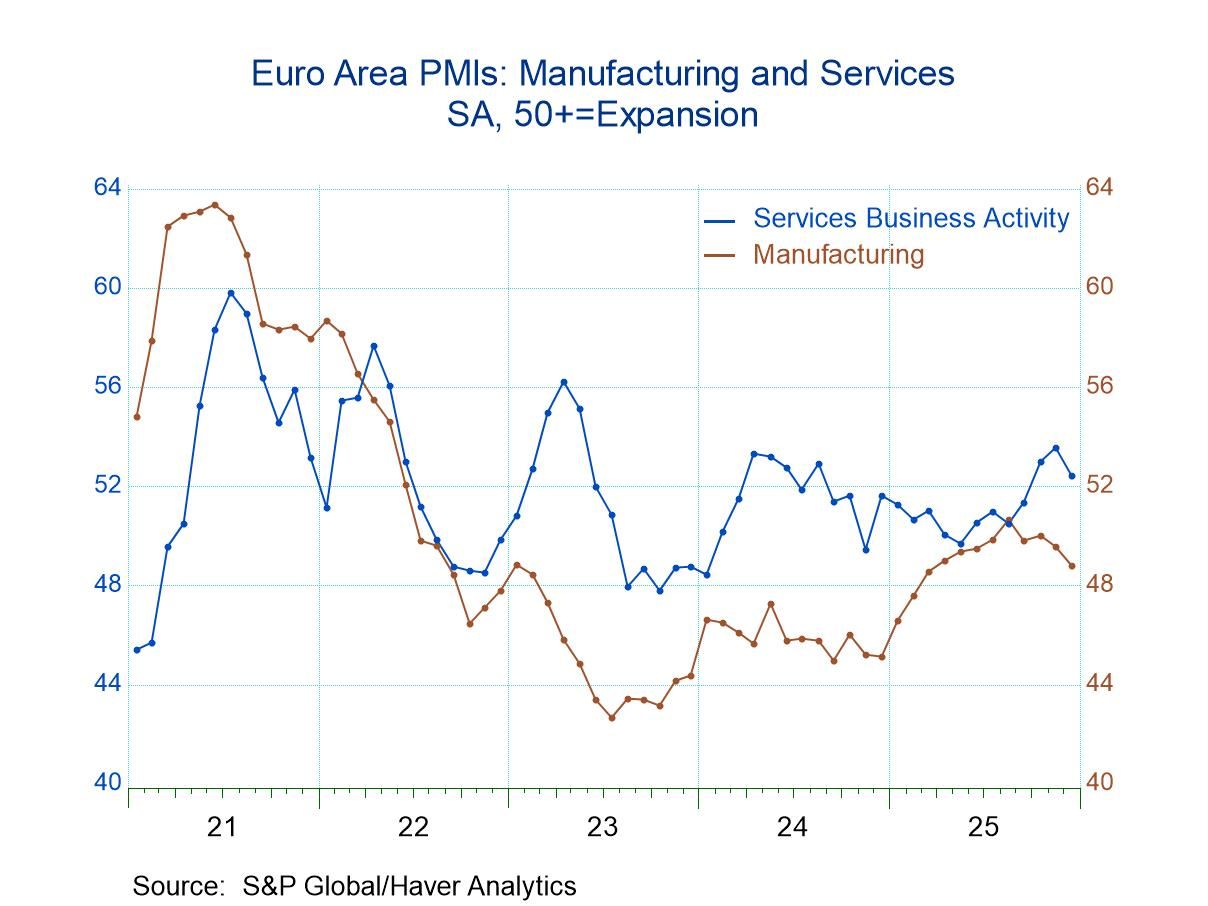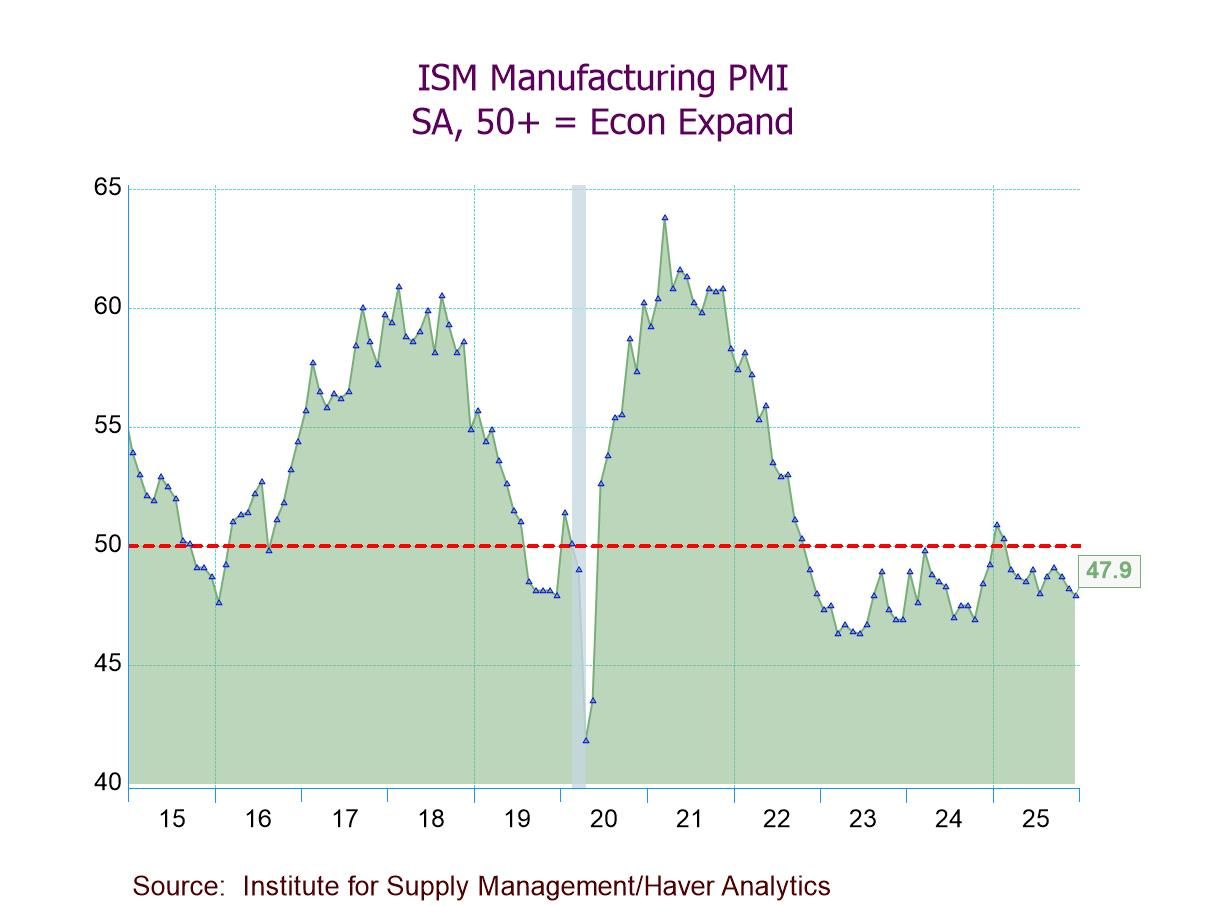 Global| Dec 20 2013
Global| Dec 20 2013U.S. GDP Growth Is Revised Upward With Improved Consumer Spending
by:Tom Moeller
|in:Economy in Brief
Summary
Real GDP growth for Q3'13 was revised up again, this time to 4.1% (2.0% y/y) from 3.6%. Growth was the firmest since Q4'11 and outpaced consensus expectations for a 3.6% rise in the Action Economics survey. Domestic final sales rose [...]
Real GDP growth for Q3'13 was revised up again, this time to 4.1% (2.0% y/y) from 3.6%. Growth was the firmest since Q4'11 and outpaced consensus expectations for a 3.6% rise in the Action Economics survey.
Domestic final sales rose at a 2.3% rate (1.6% y/y), revised up from last month's 1.8% estimate. A quickened 2.0% gain (1.9% y/y) in personal consumption expenditures drove the increase. Growth was driven by a quickened 7.9% increase (7.6% y/y) in spending on durable goods. Spending on home furnishings surged at a 13.3% rate (7.7% y/y) while motor vehicles purchases rose at a 4.9% rate (5.7% y/y). Nondurable goods spending growth also was raised to 2.9% (2.0% y/y). Gasoline expenditures rose at a 3.1% rate (0.3% y/y) though apparel spending fell at a 4.4% clip (+0.4% y/y). Spending on services was raised to a still measly 0.7% (1.0% y/y) growth rate.
Growth in business fixed investment also was firmer than estimated last month. The 4.8% advance (3.7% y/y) was driven by 13.4% growth (3.9% y/y) in nonresidential structures. Growth in producers durable equipment was a miniscule 0.2% (3.4% y/y). Residential investment growth was lowered to a still-firm 10.3% (14.2% y/y) .
In the government sector, the 0.4% advance (-2.7% y/y) in spending was unchanged but remained the first positive indication in a year. It reflected a 1.7% rise (-0.1% y/y) in state & local outlays, offset by a 1.5% decline (-6.5% y/y) in federal spending. Nondefense federal spending fell at a 3.1% rate (-2.2% y/y) which roughly equaled the declines of the prior two quarters. Defense spending slipped at a 0.3% rate (-8.9% y/y).
A faster rate of inventory accumulation continued to drive GDP growth last quarter. Inventories added 1.7 percentage points to the Q3 GDP increase. During the last year, however, inventories added a nominal 0.2 percentage points to GDP growth. Foreign trade deficit improvement helped growth but minimally. It was the result of a 3.9% rise (2.9% y/y) in exports which outpaced a 2.4% gain (1.6% y/y) in imports.
After tax corporate profits with IVA and CCA increased a little-changed 2.4% (8.6% y/y). Before-tax earnings gained 1.9% (5.7% y/y), the increase driven by a 4.1% rise (1.8% y/y) in foreign sector earnings. Financial sector profits grew 2.1% (3.2% y/y) while nonfinancial sector earnings rose 1.0% (8.0% y/y).
The GDP price index rose at an unchanged 2.0% rate (1.3% y/y), the quickest quarterly growth in a year. Consumer prices increased at a lessened 1.9% rate (1.1% y/y) while prices excluding food & energy rose at a 1.4% rate (1.2% y/y). The residential investment price index rose at a 5.2% rate (5.2% y/y) while the business fixed investment price index increased at a 1.2% pace (1.1% y/y).
The latest GDP figures can be found in Haver's USECON and USNA databases; USNA contains basically all of the Bureau of Economic Analysis' detail in the national accounts, including the new integrated economics accounts and the recently added GDP data for U.S. Territories. The Action Economics consensus estimates can be found in AS1REPNA.
| Chained 2009 $, %, AR | Q3'13 (3rd Estimate) | Q3'13 (2nd Estimate) | Q3'13 (Advance) | Q2'13 | Q1'13 | Q3 Y/Y | 2012 | 2011 | 2010 |
|---|---|---|---|---|---|---|---|---|---|
| Gross Domestic Product | 4.1 | 3.6 | 2.8 | 2.5 | 1.1 | 2.0 | 2.8 | 1.8 | 2.5 |
| Inventory Effect | 1.7 | 1.7 | 0.8 | 0.4 | 0.9 | 0.2 | 0.2 | -0.2 | 1.5 |
| Final Sales | 2.5 | 1.9 | 2.0 | 2.1 | 0.2 | 1.7 | 2.6 | 2.0 | 1.0 |
| Foreign Trade Effect | 0.1 | 0.1 | 0.3 | -0.1 | -0.3 | 0.2 | 0.2 | 0.2 | -0.5 |
| Domestic Final Sales | 2.3 | 1.8 | 1.7 | 2.1 | 0.5 | 1.6 | 2.4 | 1.8 | 1.5 |
| Demand Components | |||||||||
| Personal Consumption | 2.0 | 1.4 | 1.5 | 1.8 | 2.3 | 2.0 | 2.2 | 2.5 | 2.0 |
| Business Fixed Investment | 4.8 | 3.5 | 1.6 | 4.7 | -4.6 | 3.5 | 7.3 | 7.6 | 2.5 |
| Residential Investment | 10.3 | 13.0 | 14.6 | 14.2 | 12.5 | 14.2 | 12.9 | 0.5 | -2.5 |
| Government Spending | 0.4 | 0.4 | 0.2 | -0.4 | -4.2 | -2.7 | -1.0 | -3.2 | 0.1 |
| Chain-Type Price Index | |||||||||
| GDP | 2.0 | 2.0 | 1.9 | 0.6 | 1.3 | 1.3 | 1.7 | 2.0 | 1.2 |
| Personal Consumption | 1.9 | 2.0 | 1.9 | -0.1 | 1.1 | 1.1 | 1.8 | 2.4 | 1.7 |
| Less Food/Energy | 1.4 | 1.5 | 1.4 | 0.6 | 1.4 | 1.2 | 1.8 | 1.4 | 1.3 |
Tom Moeller
AuthorMore in Author Profile »Prior to joining Haver Analytics in 2000, Mr. Moeller worked as the Economist at Chancellor Capital Management from 1985 to 1999. There, he developed comprehensive economic forecasts and interpreted economic data for equity and fixed income portfolio managers. Also at Chancellor, Mr. Moeller worked as an equity analyst and was responsible for researching and rating companies in the economically sensitive automobile and housing industries for investment in Chancellor’s equity portfolio. Prior to joining Chancellor, Mr. Moeller was an Economist at Citibank from 1979 to 1984. He also analyzed pricing behavior in the metals industry for the Council on Wage and Price Stability in Washington, D.C. In 1999, Mr. Moeller received the award for most accurate forecast from the Forecasters' Club of New York. From 1990 to 1992 he was President of the New York Association for Business Economists. Mr. Moeller earned an M.B.A. in Finance from Fordham University, where he graduated in 1987. He holds a Bachelor of Arts in Economics from George Washington University.


